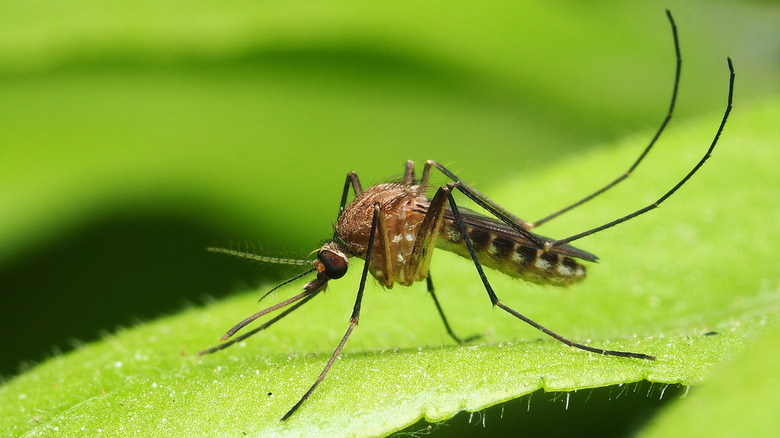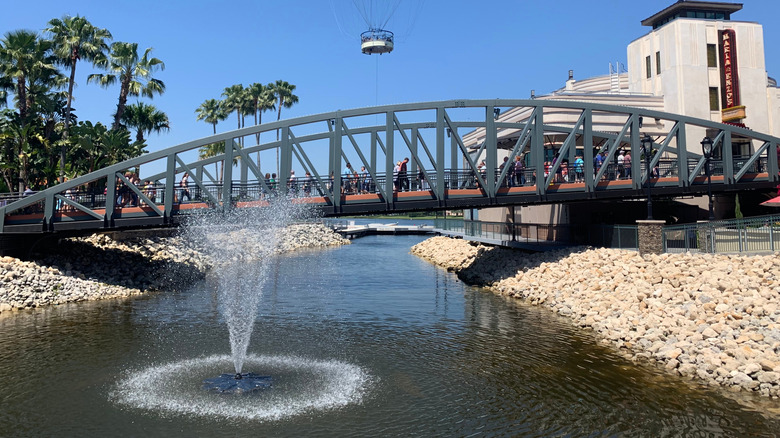Why There Aren't Very Many Mosquitoes At Disney World
When planning a trip to Disney World, there are a lot of potential annoyances to account for. From long lines to sweltering humidity to swarms of overwrought children screaming for a little facetime with their favorite cartoon mouse, a trip to Disney World is often laden with stressors. One thing that visitors don't have to worry much about, however, is the presence of nagging mosquitoes (via Insider). As Snopes points out, Disney World is not exactly completely mosquito-free, and several guests have taken to online forums to lament their experiences with the hated insects. According to the Florida Department of Health, mosquitoes are a public issue and you'd be hard-pressed to find someone who doesn't loathe the creatures. However, the park takes extra measures to keep the skeeter population down as much as possible.
ClickOrlando adds that out of 3,500 mosquito species, 80 are native to Florida. Furthermore, their population reaches a high point during the summer months. This is due to the state's tropical-like conditions in which mosquitoes flourish. Besides being a nuisance, Orkin reports that Florida mosquitoes are known to carry diseases such as malaria and dengue, for starters. Considering the theme park's location on the outskirts of a vast Floridian swamp, the Magic Kingdom's practically bug-free bona fides seem almost, well, magic (per the Tampa Bay Times). So how does the happiest place on Earth live up to its reputation in the pest control department?
Per Disney World, the theme park has lengthy procedures to ensure that guests encounter the fewest amount of mosquitos possible, and Reader's Digest explains that these measures were implemented before Disney World was even built. The secrets lie in the architecture, chickens, and more.
Joe Potter to the rescue
As it turns out, the mosquito management at Disney is the result of a highly-coordinated effort in park design and maintenance, owing much to founder Walt Disney's relationship with former general, engineer, and MIT graduate Joe Potter (via Inside the Magic). Potter had served as regional governor of the Panama Canal Zone, a location that Insect Week notes has an infamous mosquito problem. A true autodidact, Potter versed himself thoroughly in pest control to contain the incidences of insect-borne illness. After meeting Potter at the World's Fair, Disney subsequently hired him to assist with his nascent "Florida Project."
The future theme park magnate had just purchased an ample piece of land in the Sunshine State — a plot that was plagued by alligators, snakes, and, of course, mosquitoes (per the Tampa Bay Times). Fearing the effects a malaria outbreak might have on his plans for the land, Disney made mosquito control an early priority in Disney World's design. Fortunately for Disney, Potter had just the special sauce the cartoonist was looking for.
Disney expert, Christopher Lucas, told the Tampa Bay Times, "One of his things that he learned from the Panama Canal where people were dying of malaria was if you let water just sit there, you're going to have a problem." Lucas added, "He insisted to Walt, whatever we do, wherever there's water, we got to make sure it's either running off, moving, or it's just not sitting there, or you're going to have a lot of mosquitoes." Reader's Digest reports that Potter's course of action was to destroy the insect's natural habitat.
Keep that water moving
According to Reader's Digest, Potter helped Walt outfit Disney World with exceptional drainage ditches to ensure that there was never any still water at the park. Per Inside the Magic, although guests rarely notice this detail, every single water element in the park maintains perpetual motion whether it be generated by a massive waterfall a la Splash Mountain, or a subtle artificial current. Moreover, the park's buildings were designed to prevent water (from rain or other sources) from collecting and becoming a mosquito breeding ground. Lucas stated, "They made every building there curved, or designed in a way so there'd be no place for the water to catch and sit there."
Lucas also told Reader's Digest that the plants at the park were chosen to ensure they won't collect water. But as Insider explains, controlling mosquito reproduction was only the first half of the battle. In case any errant mosquito managed to slip the perimeter, Southern Living writes that the park implemented a state-of-the-art mosquito surveillance system that deploys garlic spray and natural predators like bats to keep any invading bloodsuckers under control. In addition, the fish in the park's ponds were specifically picked because they eat mosquitoes.
Insider reports that Disney World does use traditional mosquito traps to keep them at bay. Interestingly, the park also keeps sentinel chickens. Volusia County Florida states that the chickens can become infected but not sick with diseases transmitted by mosquitoes. Thus, blood samples are taken to ensure that the mosquitoes at Disney World are disease free.


